Running a dealership today means competing not only on the lot, but online too. Car dealership SEO (search engine optimization) helps you appear in search results when people nearby look for cars, financing, or service.
For most buyers, the search starts online. They compare models, check reviews, and choose which dealership to visit long before setting foot in a showroom. Optimizing your site for local searches, customer trust, and mobile usability ensures those buyers see your inventory first and book appointments with you instead of someone else.
Let’s walk through 14 proven, actionable ways to make your dealership more visible, trustworthy, and competitive in search.
1. Set Up Accurate Tracking to Measure Every Lead
You can’t improve what you can’t measure. Accurate tracking helps you understand which marketing efforts lead to calls, form submissions, and showroom visits.
Start by connecting your site to Google Analytics 4 (GA4) and Google Search Console (GSC). GA4 tracks key actions like phone clicks, lead form submissions, and trade-in tool usage. GSC shows which keywords and pages bring visitors from search.
Set up event tracking for:
- Phone clicks and form submissions: These indicate high buyer intent and should be your main conversion metrics.
- Chat and text actions: Many mobile users prefer messaging over calling.
- Trade-in, finance, and appointment requests: These are your bottom-funnel leads.
Use clear event names like form_submit_lead or click_to_call to make reporting easier. Review metrics weekly so you can see what’s improving and where visitors drop off.
2. Optimize Your Google Business Profile for Local Visibility
Your Google Business Profile (GBP) is the key to appearing in Google Maps and the Map Pack (the local listings shown at the top of the search results page). For a car dealership, this is where many buyers decide who to visit.
To optimize your GBP:
- Fill out every field: Add your complete address, phone number, hours, website link, and full list of services so customers can easily find accurate details without having to search elsewhere. A fully completed profile helps Google understand your business and boosts your visibility in local results.
- Add vehicles and offers as “Products”: Showcase featured models, seasonal promotions, and financing options to turn casual browsers into buyers. These listings appear directly in search results, giving shoppers a preview of what’s available before visiting your site.
- Upload new photos and videos weekly: Google favors active profiles, and fresh visuals help your dealership stand out in the Map Pack. Use a mix of interior, exterior, and staff photos to make your listing feel current and trustworthy.
- Post updates: Share time-sensitive offers, special events, or service discounts through Google Business Profile (GBP) Posts. Frequent updates show both customers and Google that your business is active and engaged.
- Respond to reviews: Reply to every review within one to three days to show that you value feedback and care about customer experience. Consistent, thoughtful replies help build trust and can influence new customers researching where to buy.
3. Create Dedicated Landing Pages for Each Location and Department
Dedicated landing pages help visitors find the right information without having to navigate through multiple menus. Each page should serve a specific purpose: whether it’s promoting your sales department, service center, parts department, or financing options.
These pages also allow you to target localized search terms like “car repair in Dallas” or “auto financing in Denver,” helping your site appear in more relevant searches.
When structured correctly, they send strong signals to Google that your dealership serves multiple local areas, not just one physical location.
Include Department Details and Contact Information
Start by giving each landing page clear, accurate details that make it easy for visitors to contact you. Include your department’s address, phone number, business hours, and a map with driving directions.
This basic information establishes trust and improves your visibility in Google’s local results. Make sure your contact details match exactly across your website and Google Business Profile because even small inconsistencies can confuse search engines and hurt your rankings.
Feature Vehicles and Offers Relevant to Each Location
Highlight vehicles, promotions, and financing offers that reflect your local audience’s interests. A sales page might feature high-demand models in your area, while a service page could promote seasonal maintenance specials.
Include high-quality images, concise descriptions, and clear calls to action like “Book an Appointment” or “Get Financing.” Updating these offers regularly tells Google your pages are fresh and shows customers that your dealership is active and customer-focused.
Add Staff Photos and Short Bios to Build Credibility
Showcasing your team helps customers feel more connected and comfortable reaching out. Add professional headshots, first names, and short bios for key staff members in each department.
Mention their experience, certifications, or areas of expertise to demonstrate reliability. This personal touch builds trust, especially for service or financing pages where buyers value human connection and expert guidance.
Target Local Keywords to Capture Nearby Searches
Each landing page should target one main local keyword, such as “auto repair in Dallas” or “car dealership in Denver.” Include it naturally in your title tag, meta description, H1, and first paragraph to clarify relevance.
Reinforce it with related phrases such as nearby neighborhoods, major roads, or landmarks throughout the copy. This approach helps your pages rank for both typed and voice searches like “best dealership near me,” which are increasingly common among mobile users.
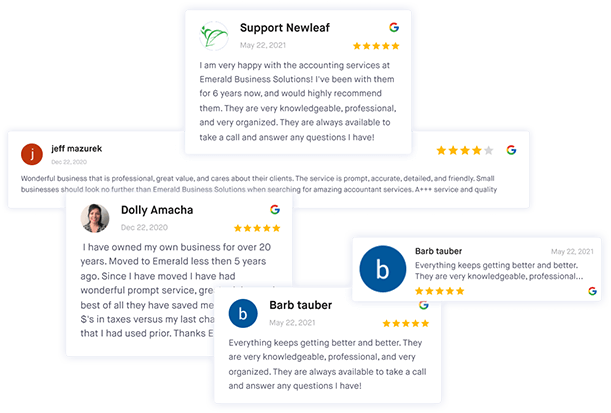
Manage online reviews with ease
Monitor, manage, and get more online reviews for your car dealership with ReviewsOnMyWebsite.
4. Build a Clear Site Structure for Makes, Models, and Trims
A logical website structure helps both visitors and Google find your inventory. Think of it as your virtual showroom.
Use a simple, hierarchical flow:
Homepage → Make Page → Model Page → Trim Page → Vehicle Detail Page (VDP)
This setup ensures that every car is only a few clicks away, and each model or trim can rank for its own search term.
Include internal links from make pages to relevant models, and vice versa. For example, if someone views your “Toyota” page, link to “Camry,” “Corolla,” and “RAV4” pages. Add breadcrumb navigation so users can backtrack easily.
5. Develop Model and Trim Pages That Match Buyer Intent
Buyers often search by model and trim, such as “2024 Ford F-150 XLT” or “2025 Toyota Camry SE.” Creating detailed pages for each variation helps your dealership appear in those specific searches and capture buyers who are ready to take the next step.
These pages also signal to Google that your site offers depth and relevance, improving your chances of ranking above competitors who only list general inventory pages.
- Use a descriptive title and H1: Include the full make, model, and trim name to match how shoppers search online and help Google understand the page’s focus. Clear, specific titles improve both visibility and click-through rates.
- Write a detailed overview: Highlight key features such as performance, safety, interior design, and fuel efficiency to help buyers make informed decisions. Keep paragraphs short and easy to scan, with benefits explained in plain language.
- Add high-quality images and 360° views: Visual content helps buyers explore vehicles from every angle and builds confidence in their choice. Include both exterior and interior shots, and make sure they load quickly on mobile devices.
- Include clear calls to action: Add “Schedule a Test Drive” or “Check Availability” buttons in multiple sections so users can act at any point on the page. Each button should lead directly to a simple form or contact option.
- Add local context to every page: Mention your dealership name, city, and phone number to reinforce local relevance. When optimized correctly, these model pages can rank for high-intent searches that often lead directly to showroom visits.
6. Improve Vehicle Detail Pages (VDPs) for Better Conversions
Your Vehicle Detail Pages are where online research turns into real leads. Treat them like product pages in e-commerce.
Focus on three goals: clarity, trust, and action. Here’s what to do:
- Use unique, descriptive content: Avoid copying manufacturer specs word-for-word and instead explain what makes each vehicle special from your dealership’s perspective. Share insights about popular trims, local demand, or standout features to make the content feel original and trustworthy.
- Add transparent pricing: Include clear pricing details, fees, and financing options whenever possible. Shoppers appreciate honesty, and transparent information builds trust while reducing friction during the sales process.
- Show reviews and testimonials: Feature real customer feedback to reinforce credibility and build confidence in your dealership. Highlight quotes from recent buyers who mention the specific model or service experience.
- Highlight availability: Clearly show whether the vehicle is currently in stock, available for order, or arriving soon. This helps manage buyer expectations and encourages faster decisions from shoppers ready to purchase.
Visitors often check multiple VDPs before calling. Keeping your pages up to date and trustworthy improves conversions and prevents drop-offs caused by inaccurate listings or missing information.
7. Manage Expired and Aged Inventory Pages the Right Way
Outdated listings can harm your SEO if not handled properly. Every time a vehicle sells, you create a “dead” page that might still be indexed by Google.
Set up a clear process for managing old inventory:
- Redirect sold vehicles: Use a 301 redirect to send traffic from sold vehicle pages to the most relevant model or trim page. This preserves any existing SEO value and keeps visitors on your site instead of landing on a dead page.
- Avoid deleting pages outright: Removing pages can create “404 Not Found” errors that hurt user experience and waste crawl budget. Redirecting instead ensures both search engines and shoppers reach useful content.
- Review your XML sitemap monthly: Remove links to inactive or sold vehicles so Google only crawls active pages. A clean sitemap helps search engines understand your current inventory and index it faster.
- Consolidate similar listings: When multiple listings overlap, such as identical models with minor differences, redirect or merge them into a single, up-to-date page. This strengthens your SEO signals and simplifies navigation for users.
These steps keep your site clean and prevent Google from wasting crawl budget on outdated pages. A healthy technical foundation supports all other SEO improvements.
8. Apply On-Page SEO Best Practices Across Your Website
On-page SEO refers to optimizing elements you control directly on your site: titles, headings, content, and links.
Every page should include:
- Descriptive title tags and meta descriptions: Keep title tags under 60 characters and include your target keyword naturally near the beginning. Write meta descriptions that summarize the page in one or two sentences and encourage users to click.
- Relevant headings (H1, H2, H3): Use clear, scannable headings that reflect what the page is about and match common search phrases. Structured headings make it easier for both users and Google to understand your content.
- Internal links: Connect related pages, such as different trims, service options, or financing details, to guide users through your site. Internal linking also helps distribute authority and improves how search engines crawl your pages.
- Alt text for images: Describe what each image shows in a short, natural sentence that includes relevant keywords. Alt text improves accessibility for users with screen readers and helps your images appear in search results.
9. Add Structured Data to Enhance Search Visibility
Structured data, also called schema markup, is a small piece of code added to your website that helps Google understand your content more clearly. It tells search engines exactly what your business offers, where you are located, and what customers think of you.
For car dealerships, this data can make your listings stand out in search results with extra details like star ratings, prices, and vehicle availability.
You don’t need to handle the technical setup yourself. Ask your developer or web provider to implement it and verify everything using Google’s Rich Results Test.
Here are the most useful types of schema to include on your dealership’s website:
- LocalBusiness schema: Defines your dealership’s name, address, phone number, and business hours so Google can accurately display your information in local search results. This makes your listing more visible in the Map Pack and helps customers find your location easily.
- Product or Vehicle schema: Adds structured information about each car, including make, model, year, price, and availability. When properly implemented, these details can appear directly in Google search results and attract high-intent shoppers.
- FAQPage schema: Helps questions and answers from your website appear as rich results below your main listing. This gives searchers quick answers and can increase engagement with your pages.
- Review snippets: Display your average star rating and review count directly in search results. These visual elements build trust and often improve click-through rates by showing social proof before customers visit your site.
10. Optimize Mobile Experience and Core Web Vitals
Most buyers browse inventory from their phones, so mobile usability directly affects your bottom line.
Core Web Vitals are Google’s measures of user experience:
- Largest Contentful Paint (LCP): How quickly your page loads.
- Interaction to Next Paint (INP): How responsive your page feels.
- Cumulative Layout Shift (CLS): How stable the page layout is as it loads.
To improve mobile performance:
- Compress large images and enable lazy loading.
- Remove unnecessary scripts that slow pages down.
- Keep tap targets large and menus simple.
Run tests in Google PageSpeed Insights and monitor your results quarterly. Faster pages lead to better rankings and fewer impatient visitors leaving before seeing your vehicles.
11. Collect and Showcase Customer Reviews Across Key Pages
Customer reviews are one of the strongest trust signals for both Google and potential car buyers. They directly influence your dealership’s visibility in search, your reputation in the community, and the likelihood that a buyer chooses you over a competitor.
A steady flow of new, authentic reviews shows that your business is active, responsive, and focused on customer satisfaction.
Collect Reviews Consistently After Sales and Service
Ask every satisfied customer to share their experience shortly after a sale or service appointment.
Train your team to ask in person, and follow up with a short, polite email or text that includes a direct link to your Google review page. Timing is key: send the request within 24 hours while the experience is still fresh in the customer’s mind.
Pro tip: You can use ReviewsOnMyWebsite to set up automated email and SMS review request campaigns, ensuring every buyer gets asked to leave a review.

Manage online reviews with ease
Monitor, manage, and get more online reviews for your car dealership with ReviewsOnMyWebsite.
Monitor and Manage Reviews Across All Platforms
Keeping track of reviews across multiple platforms helps you stay in control of your reputation. According to our research, 55% of businesses monitor reviews on two to three platforms, while only 22% track four or more, leaving opportunities for proactive dealerships to stay ahead.
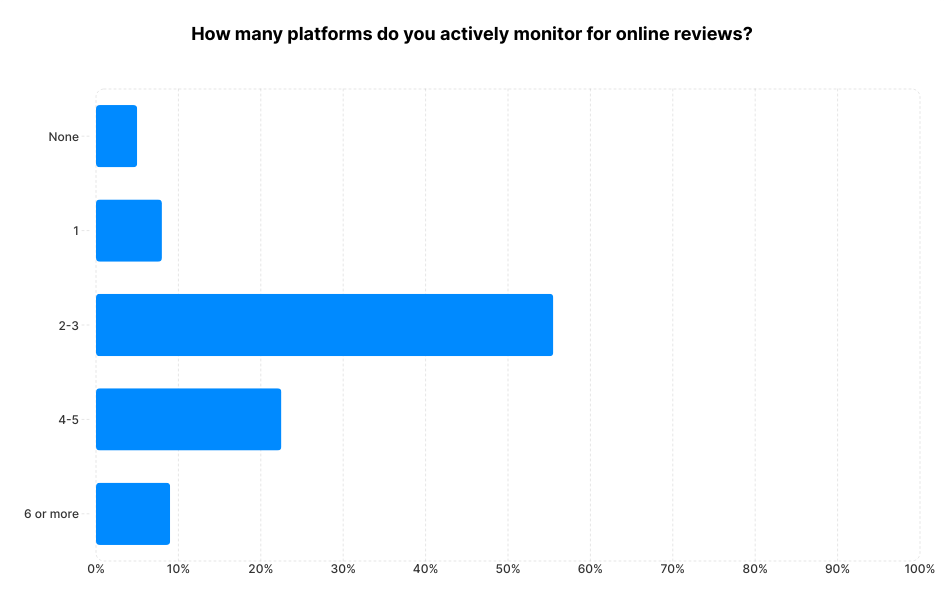
Make it a weekly routine to check your profiles on Google, Facebook, Yelp, and automotive-specific sites like Cars.com or DealerRater. Respond quickly and professionally to every review, especially negative ones, to show that you care about resolving customer issues.
You can use ReviewsOnMyWebsite to track your business’s reviews across 26+ platforms, and read and respond to every review from one central location.
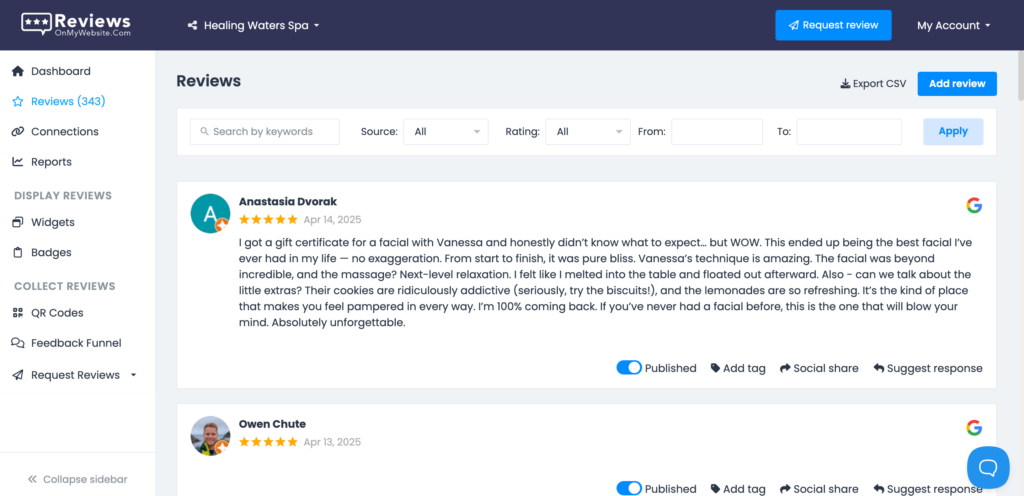
Display Reviews Prominently on Key Pages
Feature your best customer reviews on high-traffic pages such as your homepage, vehicle detail pages, and service pages. Displaying real quotes from satisfied buyers helps new visitors feel more confident about doing business with you.
Showcasing reviews is easy with ReviewsOnMyWebsite’s customizable review widget. All you need to do is add a piece of code to your site.
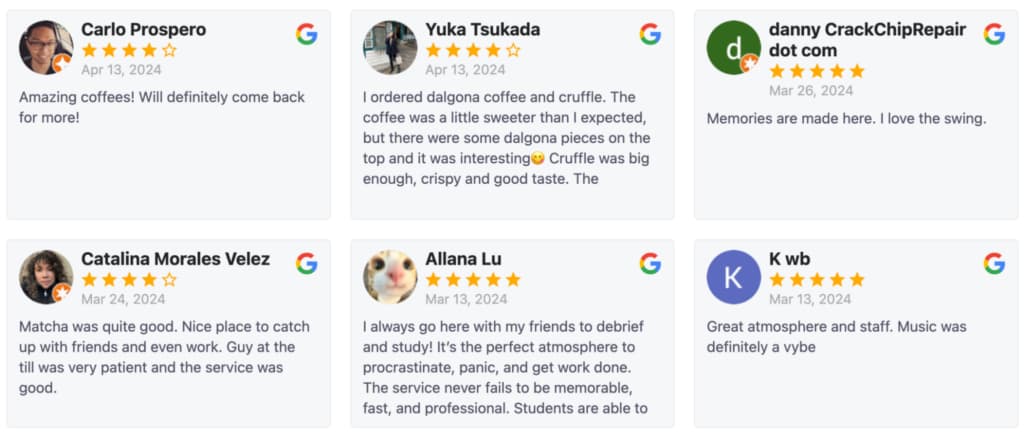
Reviews on VDPs can reassure customers who are close to making a decision, while service page testimonials emphasize reliability and quality.
Respond Quickly and Thoughtfully to Every Review
Whether the review is positive or negative, a fast and professional response shows customers that you value their feedback. Acknowledge the reviewer by name, thank them for their time, and address any concerns directly.
According to the State of Online Reputation Management, 45% of businesses respond to reviews within one to two days, while 34% reply within a few hours, which sets a clear benchmark for your team to follow.
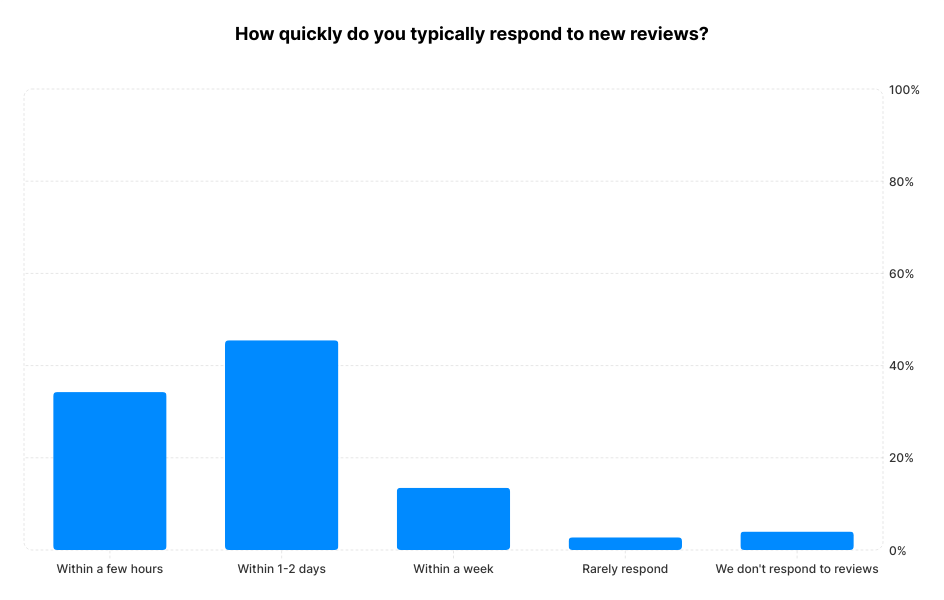
Consistent communication builds trust, reinforces your brand’s professionalism, and turns satisfied customers into long-term advocates.
12. Build Local Backlinks
Backlinks are links from other websites pointing to yours. They signal to Google that your site is credible and authoritative.
When building backlinks, focus on quality over quantity:
- Join local directories: List your dealership on trusted platforms such as Google, Yelp, Bing Places, and Apple Business Connect. These listings help boost local visibility and can generate valuable backlinks that strengthen your domain authority.
- Partner with community organizations: Sponsor local events, schools, or charities that align with your brand. These partnerships often include backlinks from their websites, while also improving your reputation and local brand awareness.
- Work with local media: Send press releases to newspapers, radio stations, or local news sites whenever you launch new inventory, win an award, or host an event. Media coverage builds credibility and earns high-quality backlinks from authoritative domains.
- Collaborate with nearby businesses: Form partnerships with complementary businesses such as auto repair shops, insurance agents, or car wash services. Cross-promoting each other through blog posts or referral pages can generate relevant, local backlinks.
- Publish local resource content: Create guides or articles that highlight local driving routes, maintenance tips for regional weather, or community events. Local websites are more likely to reference and link to helpful content that serves their audience.
13. Publish Helpful Content That Attracts Local Buyers
Content marketing helps your dealership reach buyers earlier in their research phase, before they’ve decided where to buy. By creating educational, search-focused content, you can attract visitors who are still comparing options and build trust before they ever contact your sales team.
The key is to publish content that directly answers the questions your customers are already asking.
Write About Topics Your Customers Actually Search For
Focus on subjects that align with common buyer questions, such as “Best time of year to buy a used car,” “How to finance your first vehicle,” or “What’s included in a 30,000-mile service.”
These are the kinds of searches buyers perform before they visit a dealership, giving you a chance to reach them first.
Use keyword tools like Semrush or AnswerThePublic to identify related local phrases your audience is searching for. By providing clear, useful answers, your content becomes a trusted source rather than another sales pitch.
Add Local Cues to Strengthen Relevance
Include your dealership name, city, and nearby landmarks naturally throughout your blog posts and guides. These small local touches help Google understand where your business operates and make your content more relevant for “near me” searches.
For example, a post titled “How to Finance a Car in Dallas” connects your dealership directly to high-intent local searches. This also builds familiarity among local readers who recognize your name and location.
Link Back to Core Pages Strategically
Every piece of content should guide readers deeper into your website. Link relevant keywords to your main pages, such as your inventory, service, or financing sections, to improve navigation and keep visitors engaged.
These internal links help search engines understand your site structure and distribute ranking power across important pages. Over time, this supports higher visibility for your most valuable commercial keywords.
Keep Publishing Consistently
SEO success comes from steady, ongoing effort rather than one-time campaigns. Create a publishing schedule that fits your team’s capacity, even if that means posting once or twice a month.
Focus on quality over quantity. Helpful, well-written articles will keep earning clicks and rankings long after ads have stopped running. Regular updates also show Google that your website is active and relevant, which can lead to stronger long-term performance.
Frequently Asked Questions
How Long Does It Take to See SEO Results?
SEO typically takes 3–6 months to show significant improvements. Factors like site age, competition, and local authority affect the timeline. Consistency and accurate tracking make progress easier to measure and accelerate.
Should You Hire an SEO Agency or Do It In-House?
If you have time and staff for ongoing updates, handling SEO internally can work. Many smaller dealerships, however, benefit from working with a specialist who can manage technical tasks and reporting. The key is to stay consistent.
How Important Are Reviews for SEO?
Reviews are critical. They influence rankings, click-through rates, and trust. A strong review profile with quick, thoughtful responses signals reliability to both customers and Google.
Drive More Local Buyers with a Consistent SEO Process
Winning in search is not about one big change; it’s about consistency. When you track results, keep your Google profile active, update your inventory pages, and showcase reviews, you build momentum that compounds over time.
By focusing on visibility, credibility, and customer experience, your dealership can attract more local buyers, close more deals, and build a reputation that keeps driving referrals.
Implement these strategies step by step, and watch your online presence become one of your strongest sales tools.




